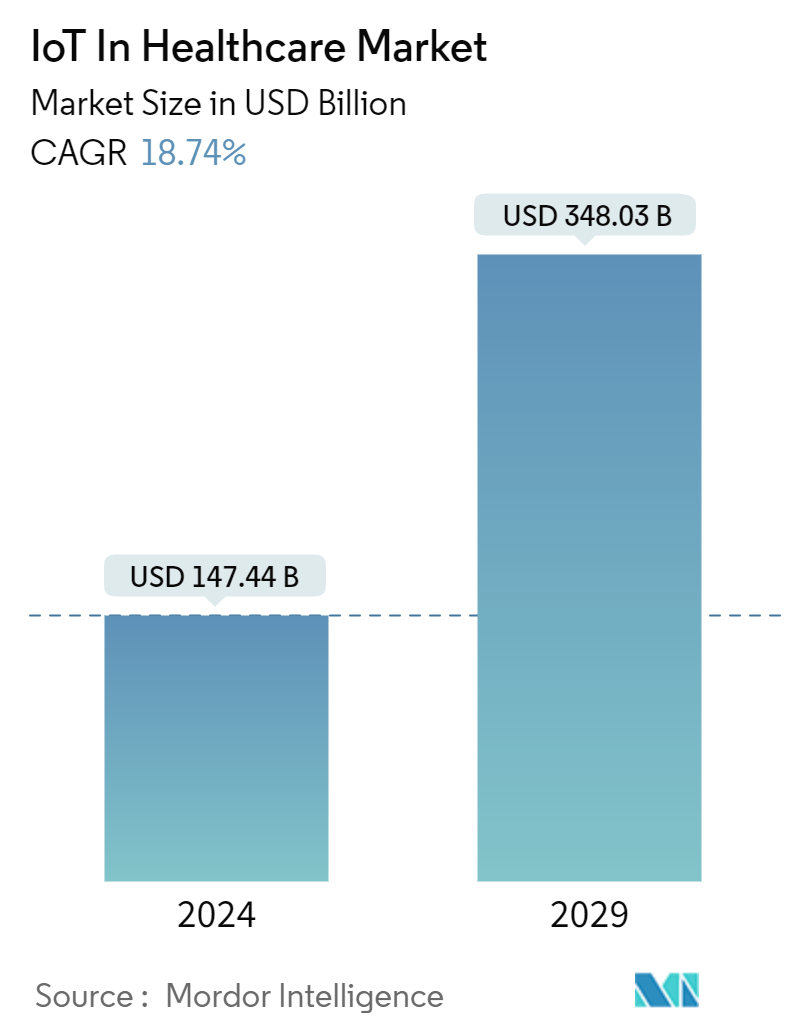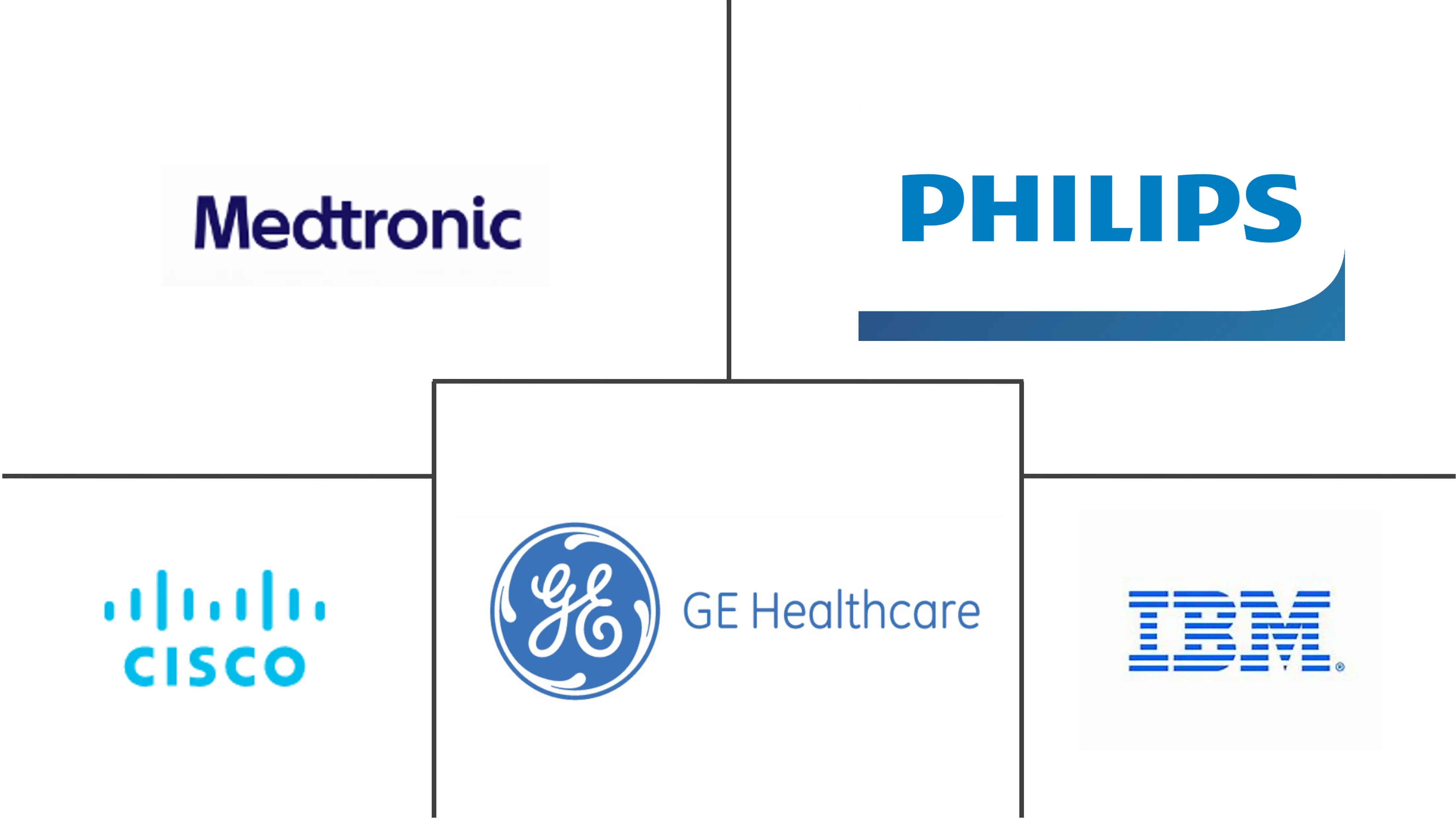Market Size of IoT In Healthcare Industry

| Study Period | 2019 - 2029 |
| Market Size (2024) | USD 147.44 Billion |
| Market Size (2029) | USD 348.03 Billion |
| CAGR (2024 - 2029) | 18.74 % |
| Fastest Growing Market | Asia Pacific |
| Largest Market | North America |
| Market Concentration | Low |
Major Players
*Disclaimer: Major Players sorted in no particular order |
Internet of Things (IoT) in Healthcare Market Analysis
The IoT In Healthcare Market size is estimated at USD 147.44 billion in 2024, and is expected to reach USD 348.03 billion by 2029, growing at a CAGR of 18.74% during the forecast period (2024-2029).
The IoT market is driven by the growing adoption of healthcare information systems, the emergence of big data in healthcare, improved device accuracy and connectivity, and the increasing penetration of connected devices in healthcare.
- IoT technology has the potential to revolutionize traditional paper-based healthcare treatment by simplifying access to remote patient monitoring and real-time patient data. The emergence of this digital healthcare technology has addressed the impending need for better diagnostics and targeted therapeutic tools. In addition, it provides remote patient monitoring to physicians and works as a fitness and wellness tracker for athletes and a dosing reminder for patients. The successful implementation of IoT in the remote monitoring of asthma and diabetes patients, coupled with the high penetration of fitness and wellness devices, has created a high demand for the IoT healthcare market.
- Big data analytics is a fast-emerging topic in IoT. The demand for big data analytics integrates the most recent innovation in machine learning, logical methodologies, computational intelligence, and data mining. Many healthcare experts, including payers and providers, are now analyzing big data to obtain detailed knowledge. Even though these efforts are still in their early stages, they are expected to collectively help tackle the industry-related problems regarding inconsistency in healthcare quality and escalating healthcare expenditures. Organizations might leverage big data approaches and solutions to engage patients, personalize care, lower costs and variability, and enhance the quality of service.
- The market is driven by rising digital adoption in the healthcare industry. The healthcare sector has grown enormously due to technological advancements, digitization of healthcare, and government participation. Trends that have arisen throughout this stage have enabled modern technology to simplify further and enhance the patient experience. Nowadays, almost every element of healthcare uses technology like machine learning, automation, and artificial intelligence (AI). As a way to help doctors make more accurate diagnoses, AI and ML tools are becoming increasingly common.
- Artificial intelligence is a powerful tool that can increase the efficiency, speed, and effectiveness of the global health system. It has the potential to improve the efficiency of telemedicine. Researchers at UCLA have combined chatbot technology and an AI system to create a virtual interventional radiologist (VIR), which helps the patient self-diagnose or the doctor diagnose the patient.
- With the help of IoT, patients can convert their personal health information, such as the number of steps taken, vital signs, and calories burned, into non-personally identifiable information on the platform and store it safely, further supporting the data analysis and R&D activities of pharmaceutical companies and medical institutions to accelerate the development of medical devices and discovery of new drugs.
- Improvements in the quality of people's daily health and life activities, as well as big data analytics to support and promote such research activities, are some of the factors driving the market's growth, as IoT-based healthcare systems play a key role in the development of medical information systems. Tracking, tracing, and monitoring patients are essential to enhance the healthcare system.
- Market growth is projected to be restrained by difficulties such as the high costs of IoT infrastructure development, privacy and security concerns about data, a general lack of awareness among underdeveloped countries' populations, and a lack of technical expertise.
Internet of Things (IoT) in Healthcare Industry Segmentation
As per the scope of this report, IoT in the healthcare system context refers to every device connected to the internet for a wide range of applications, such as tracking patients or equipment, gathering data, and analyzing the received data. The study analyzes market trends and outlines the IoT in the healthcare industry.
The Internet of Things (IoT) in the healthcare market is segmented by component (medical devices, systems and software, services), application (telemedicine, inpatient monitoring, medication management, other applications), end user, and geography.
| Component | |||||
| |||||
| Systems and Software | |||||
| Services |
| Application | |
| Telemedicine | |
| Inpatient Monitoring | |
| Medication Management | |
| Other Applications |
| End User | |
| Hospitals, Clinical Research Organizations, Other End Users | |
| Clinical Research Organizations | |
| Other End Users |
| Geography*** | |||||
| |||||
| |||||
| |||||
| Australia and New Zealand | |||||
| Latin America | |||||
| Middle East and Africa |
IoT In Healthcare Market Size Summary
The IoT in healthcare market is poised for significant growth, driven by the increasing adoption of healthcare information systems and the integration of big data analytics. This digital transformation is enhancing device accuracy and connectivity, facilitating remote patient monitoring, and improving real-time data access. The market is witnessing a surge in demand due to the successful implementation of IoT technologies in managing chronic conditions like asthma and diabetes, as well as the rising use of fitness and wellness devices. The healthcare sector's shift towards digital solutions is further supported by advancements in artificial intelligence and machine learning, which are being leveraged to improve diagnostic accuracy and patient care. Despite the promising growth trajectory, the market faces challenges such as high infrastructure costs, data privacy concerns, and a lack of awareness in underdeveloped regions.
North America leads the IoT in healthcare market, benefiting from a robust infrastructure and the presence of major industry players. The region's focus on integrating intelligence into medical devices has enhanced remote monitoring capabilities, improving patient engagement and reducing hospital stays. The adoption of electronic health records is widespread, particularly in the United States, where healthcare IT firms are innovating to capture significant market share. Strategic collaborations and investments in digital health initiatives are prevalent, with companies like Honeywell and Fujitsu advancing digital transformation efforts. The market's competitive landscape is characterized by key players such as Medtronic, GE Healthcare, and Koninklijke Philips NV, who are actively pursuing mergers, acquisitions, and new product launches to strengthen their positions.
IoT In Healthcare Market Size - Table of Contents
-
1. MARKET INSIGHTS
-
1.1 Market Overview
-
1.2 Industry Value Chain Analysis
-
1.3 Industry Attractiveness - Porter's Five Forces Analysis
-
1.3.1 Threat of New Entrants
-
1.3.2 Bargaining Power of Buyers/Consumers
-
1.3.3 Bargaining Power of Suppliers
-
1.3.4 Threat of Substitute Products
-
1.3.5 Intensity of Competitive Rivalry
-
-
1.4 Assessment of COVID-19 Impact on the market
-
-
2. MARKET SEGMENTATION
-
2.1 Component
-
2.1.1 Medical Devices
-
2.1.1.1 Wearable External Medical Devices
-
2.1.1.2 Implanted Medical Devices
-
2.1.1.3 Stationary Medical Devices
-
-
2.1.2 Systems and Software
-
2.1.3 Services
-
-
2.2 Application
-
2.2.1 Telemedicine
-
2.2.2 Inpatient Monitoring
-
2.2.3 Medication Management
-
2.2.4 Other Applications
-
-
2.3 End User
-
2.3.1 Hospitals, Clinical Research Organizations, Other End Users
-
2.3.2 Clinical Research Organizations
-
2.3.3 Other End Users
-
-
2.4 Geography***
-
2.4.1 North America
-
2.4.1.1 United States
-
2.4.1.2 Canada
-
-
2.4.2 Europe
-
2.4.2.1 United Kingdom
-
2.4.2.2 Germany
-
2.4.2.3 France
-
-
2.4.3 Asia
-
2.4.3.1 China
-
2.4.3.2 Japan
-
2.4.3.3 India
-
-
2.4.4 Australia and New Zealand
-
2.4.5 Latin America
-
2.4.6 Middle East and Africa
-
-
IoT In Healthcare Market Size FAQs
How big is the IoT In Healthcare Market?
The IoT In Healthcare Market size is expected to reach USD 147.44 billion in 2024 and grow at a CAGR of 18.74% to reach USD 348.03 billion by 2029.
What is the current IoT In Healthcare Market size?
In 2024, the IoT In Healthcare Market size is expected to reach USD 147.44 billion.

